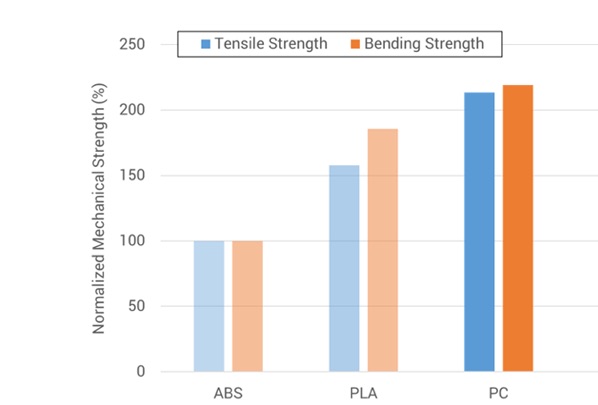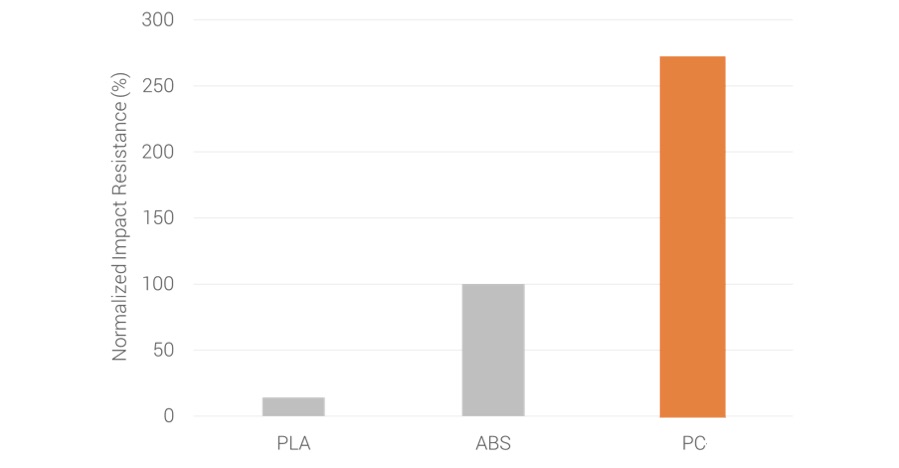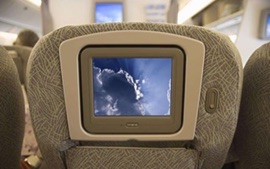WHY CHOOSE PC?
With so many material options for extrusion based 3D printing, why choose polycarbonate over another option?
Picking the correct material for the job is an important aspect of achieving your goals. For 3D printing, PLA plastic has become the standard and most popular choice for many applications. This is due to its printability, its cost and its familiarity. While PLA is a good choice for some applications, it fairs poorly under stress due to the the brittle nature of the plastic.
For those applications requiring more than just aesthetics, Polycarbonate is the natural choice. Polycarbonate has a number of inherent characteristics that set it apart from other 3D printing materials. Namely; toughness, heat resistance, optical clarity, flame retardance, tensile and bending strength.
PROPERTIES/ KEY FEATURES
Extremely strong and tough
Parts printed with polycarbonate materials display improved mechanical strength compared with ABS and PLA. In terms of tensile and bending strength, the results of polycarbonate parts are all more than twice as much as ABS, while also out performing PLA.
By far Polycarbonate’s superior mechanical property is its fracture toughness or impact resistance. It offers the absolute best in toughness that is simply unobtainable from other 3D printing materials of similar stiffness. Polycarbonate’s toughness is way higher than that of PLA and ABS.
The outstanding mechanical strength and toughness make polycarbonate an excellent choice for a wide range of engineering applications, working parts or printed assemblies.
Excellent heat resistance
Polycarbonate materials owns great heat resistance. PC 3D printing material offers better heat resistance than almost all other 3D printing materials currently in the market. It’s capable of withstanding temperatures well above 110℃.
Optical clarity
Polycarbonate material is naturally transparent, and it can show good optical clarity. This feature has made it one of the most popular materials in lighting industry.
Intrinsic flame retardance
Certain grades of polycarbonate material can be classed in the highest level of fire rating: V-0 in the UL94 testing.
ECONOMIES
Printer Compatibility
Why polycarbonate material is not popular in 3D printing since it has such great mechanical properties, heat resistance, optical clarity and fire retardance? Because it was very difficult to print it.
In the past, it usually required the 3D printer with a heated chamber up to 110-120℃ and the printing platform up to 120-150℃ to successfully print a part with the polycarbonate material. If these conditions were not met, the polycarbonate would very likely warp during printing process. In another word, only expensive industrial level 3D printers could work with it.
Now, things have changed. New 3D printing polycarbonate material created by Polymaker and Covestro will enable many more 3D printers to work with it. The new condition of working with this material becomes 70-80℃ chamber temperature and 80-110℃ printing platform temperature. It has brought down the barriers for 3D printing technology users to utilize polycarbonate.
Acceptable price
It is true that polycarbonate 3D printing material is generally more expensive than commonly used ones like PLA and ABS. But in terms of mechanical properties/price it is basically cheaper than all other engineering plastics that have the similar features like PEEK, ASA, PMMA, PA. It is qualified to be used as end-used parts, tooling or jigs & fixtures rather than rapid prototyping.
With so many great features, the printer compatibility and the affordable price, polycarbonate will surely become more and more used in a variety of applications.




